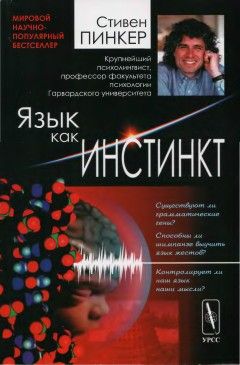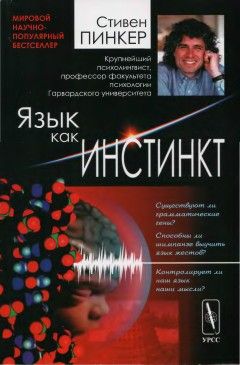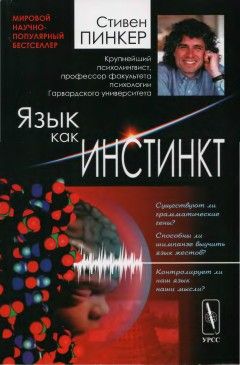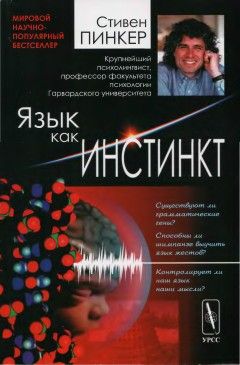Pinker S. 1994. How could a child use verb syntax to learn verb semantics? // Lingua, 92.
Pinker S. 1995. Facts about human language relevant to its evolution // J.-P. Changeux & J. Chavaillon (Eds.), Origins of the human brain. New York: Oxford University Press. P. 262–285.
Pinker S. & Birdsong D. 1979. Speakers’ sensitivity to rules of frozen word order // Journal of Verbal Learning and Verbal Behavior, 18. P. 497–508.
Pinker S. & Bloom P. & commentators. 1990. Natural language and natural selection // Behavioral and Brain Sciences, 13. P. 707–784.
Pinker S. & Mehler J. (Eds.) 1988. Connections and symbols. Cambridge, Mass.: MIT Press.
Pinker S., and Prince A. 1988. On language and connectionism: Analysis of a Parallel Distributed Processing model of language acquisition // Cognition, 28. P. 73–193.
Pinker S., and Prince A. 1992. Regular and irregular morphology and the psychological status of rules of grammar // L. A. Sutton, C. Johnson & R. Shields (Eds.), Proceedings of the 17th Annual Meeting of the Berkeley Linguistics Society: General Session and Parasession on the Grammar of Event Structure. Berkeley, Calif.: Berkeley Linguistics Society.
Plomin R. 1990. The role of inheritance in behavior // Science, 248. P. 183–188.
Poeppel D. 1993. PET studies of language: A critical review. Unpublished manuscript. Department of Brain and Cognitive Sciences, MIT.
Poizner H., Klima E. S. & Bellugi U. 1990. What the hands reveal about the brain. Cambridge, Mass.: MIT Press.
Posner M. I. (Ed.) 1989. Foundations of cognitive science. Cambridge, Mass.: MIT Press.
Prasada S. & Pinker S. 1993. Generalizations of regular and irregular morphology // Language and Cognitive Processes, 8. P. 1–56.
Premack A. J. & Premack D. 1972. Teaching language to an ape // Scientific American, October.
Premack D. 1985. «Gavagai!» or the future history of the animal language controversy // Cognition, 19. P. 207–296.
Pullum G. K. 1991. The great Eskimo vocabulary hoax and other irreverent essays on the study of language. Chicago: University of Chicago Press.
Putnam H. 1971. The «innateness hypothesis» and explanatory models in linguistics // J. Searle (Ed.), The philosophy of language. New York: Oxford University Press. (Рус. пер.: Путнам Х. «Гипотеза врожденности» и объяснительные модели в лингвистике // Философия языка / Ред.-сост. Дж. Р. Сёрл. М.: УРСС, 2004.)
Pyles T. & Algeo J. 1982. The origins and development of the English language (3rd ed.). New York: Harcourt Brace Jovanovich.
Quine W. V. O. 1960. Word and object. Cambridge, Mass.: MIT Press.
Quine W. V. O. 1969. Natural kinds // Ontological relativity and other essays. New York: Columbia University Press.
Quine W. V. O. 1987. Quiddities: An intermittently philosophical dictionary. Cambridge, Mass.: Harvard University Press.
Quirk R., Greenbaum S., Leech G. & Svartvik J. 1985. A comprehensive grammar of the English language. New York: Longman.
Radford A. 1988. Transformational syntax: A first course (2nd ed.). New York: Cambridge University Press.
Rakic P. 1988. Specification of cerebral cortical areas // Science, 241. P. 170–176.
Raymond E. S. (Ed.) 1991. The new hacker’s, dictionary. Cambridge, Mass.: MIT Press.
Remez R. E., Rubin P. E., Pisoni D. B. & Carrell T. D. 1981. Speech perception without traditional speech cues // Science, 212. P. 947–950.
Renfrew C. 1987. Archaeology and language: The puzzle of Indo-European origins. New York: Cambridge University Press.
Riemsdijk H. van & Williams E. 1986. Introduction to the theory of grammar. Cambridge, Mass.: MIT Press.
Roberts L. 1992. Using genes to track down Indo-European migrations // Science, 257, P. 1346.
Robinson B. W. 1976. Limbic influences on human speech // Harnad, Steklis & Lancaster, 1976.
Rosch E. 1978. Principles of categorization // E. Rosch & B. Lloyd (Eds.), Cognition and categorization. Hillsdale, N. J.: Erlbaum.
Ross P. E. 1991. Hard words. Scientific American, April. P. 138–147.
Rozin P. & Schull J. 1988. The adaptive-evolutionary point of view in experimental psychology // R. C. Atkinson, R. J. Herrnstein, G. Lindzey & R. D. Luce (Eds.), Stevens’s handbook of experimental psychology. New York: Wiley.
Ruhlen M. 1987. A guide to the world’s languages, Vol. I. Stanford University Press.
Rumelhart D. E., McClelland J. L. & The PDP Research Group. 1986. Parallel distributed processing: Explorations in the microstructure of cognition, Vol. I: Foundations. Cambridge, Mass.: MIT Press.
Rymer R. 1993. Genie: An abused child’s flight from silence. New York: HarperCollins.
Safire W. 1991. Coming to terms. New York: Henry Holt.
Sagan C. & Druyan A. 1992. Shadows of forgotten ancestors. New York: Random House.
Samarin W. J. 1972. Tongues of men and angels: The religious language of Pentecostalism. New York: Macmillan.
Samuels M. L. 1972. Linguistic evolution. New York: Cambridge University Press.
Sapir E. 1921. Language. New York: Harcourt, Brace, and World. (Рус. пер.: Сепир Э. Язык. Введение в изучение речи // Сепир Э. Избранные труды по языкознанию и культурологии. М.: Прогресс «Универс», 1993.)
Saussure F. de. 1916/1959. Course in general linguistics. New York: McGraw-Hill. (Рус. пер.: Соссюр Ф. де. Курс общей лингвистики // Соссюр Ф. Труды по языкознанию. М.: Прогресс, 1977.)
Savage-Rumbaugh E. S. 1991. Language learning in the bonobo: How and why they learn // Krasnegor et al. 1991.
Schaller S. 1991. A man without words. New York: Summit Books.
Schanck R. C. & Riesbeck, C. K. 1981. Inside computer understanding: Five programs plus miniatures. Hillsdale, N. J.: Erlbaum.
Searle J. (Ed.) 1971. The philosophy of language. New York: Oxford University Press. (Рус. пер.: Философия языка / Ред.-сост. Дж. Р. Сёрл. М.: УРСС, 2004.)
Seidenberg M. S. 1986. Evidence from the great apes concerning the biological bases of language // W. Demopoulos & A. Marras (Eds.), Language learning and concept acquisition: Foundational issues. Norwood, N. J.: Ablex.
Seidenberg M. S. & Petitto L. A. 1979. Signing behavior in apes: A critical review. Cognition, 7. P. 177–215.
Seidenberg M. S. & Petitto L. A. 1987. Communication, symbolic communication, and language: Comment on Savage-Rumbaugh, McDonald, Sevcik, Hopkins, and Rupert 1986 // Journal of Experimental Psychology: General, 116. P. 279–287.
Seidenberg M. S., Tanenhaus M. K., Leiman M. & Bienkowski M. 1982. Automatic access of the meanings of words in context: Some limitations of knowledge-based processing // Cognitive Psychology, 14. P. 489–537.
Selkirk E. O. 1982. The syntax of words. Cambridge, Mass.: MIT Press.
Shatz C. J. 1992. The developing brain. Scientific American, September.
Shepard R. N. 1978. The mental image // American Psychologist, 33. P. 125–137.
Shepard R. N. 1987. Evolution of a mesh between principles of the mind and regularities of the world // J. Dupre (Ed.), The latest on the best: Essays on evolution and optimality. Cambridge, Mass.: MIT Press.
Shepard R. N., and Cooper L. A. 1982. Mental images and their transformations. Cambridge, Mass.: MIT Press.
Shevoroshkin V. 1990. The mother tongue: How linguists have reconstructed the ancestor of all living languages // Sciences, 30. P. 20–27.
Shevoroshkin V. & Markey T. L. 1986. Typology, relationship, and time. Ann Arbor, Mich.: Karoma.
Shieber S. 1994. Lessons from a restricted Turing Test. Communications of the Association for Computing Machinery.
Shopen T. (Ed.) 1985. Language typology and syntactic description, 3 vols. New York: Cambridge University Press.
Simon J. 1980. Paradigms lost. New York: Clarkson Potter.
Singer P. 1992. Bandit and friends // New York Review of Books, April 9.
Singleton J. & Newport E. 1993. When learners surpass their models: the acquisition of sign language from impoverished input. Unpublished manuscript, Department of Psychology, University of Rochester.
Siple P. (Ed.) 1978. Understanding language through sign language research. New York: Academic Press.
Slobin D. I. 1977. Language change in childhood and in history // Macnamara (Ed.), Language learning and thought. New York: Academic Press.
Slobin D. I. (Ed.) 1985. The crosslinguistic study of language acquisition, Vols. 1 & 2. Hillsdale, N. J.: Erlbaum.
Slobin D. I. (Ed.) 1992. The crosslinguistic study of language acquisition, Vol. 3. Hillsdale, N. J.: Erlbaum.
Smith G. W. 1991. Computers and human language. New York: Oxford University Press.
Sokal R. R., Oden N. L. & Wilson C. 1991. Genetic evidence for the spread of agriculture in Europe by demic diffusion // Nature, 351. P. 143–144.
Solan L. M. 1993. The language of judges. Chicago: University of Chicago Press.
Spelke E. S., Breinlinger K., Macomber J. & Jacobson K. 1992. Origins of knowledge // Psychological Review, 99. P. 605–632.
Sperber D. 1982. On anthropological knowledge. New York: Cambridge University Press. Sperber, D. 1985. Anthropology and psychology: Toward an epidemiology of representations // Man, 20. P. 73–89.
Sperber D. 1994. The modularity of thought and the epidemiology of representations // Hirschfeld & Gelman (Eds.), Mapring the mind: Domain specificity in cognition and culture. New York: Camblidge University Press.
Sperber D. & Wilson D. 1986. Relevance: Communication and cognition. Cambridge, Mass.: MIT Press.
Sproat R. 1992. Morphology and computation. Cambridge, Mass.: MIT Press.
Staten V. 1992. Ol’ Diz. New York: HarperCollins.
Steele S. (with Akmajian A., Demers R., Jelinek E., Kitagawa C., Oehrle R., and Wasow T.) 1981. An Encyclopedia of AUX: A Study of Cross-Linguistic Equivalence. Cambridge, Mass.: MIT Press.
Stringer C. B. 1990. The emergence of modern humans // Scientific American, December.
Stringer C. B. & Andrews P. 1988. Genetic and fossil evidence for the origin of modern humans // Science, 239. P. 1263–1268.
Stromswold K. J. 1990. Learnability and the acquisition of auxiliaries. Doctoral dissertation, Department of Brain and Cognitive Sciences, MIT.
Stromswold K. J. 1994. Language comprehension without language production. Presented at the Boston University Conference on Language Development.
Stromswold K. J. 1994. The cognitive and neural bases of language acquisition // M. S. Gazzaniga (Ed.), The cognitive neurosciences. Cambridge, Mass.: MIT Press.
Stromswold K. J., Caplan D. & Alpert N. 1993. Functional imaging of sentence comprehension. Unpublished manuscript, Department of Psychology, Rutgers University.
Studdert-Kennedy M. 1990. This view of language // Pinker & Bloom. 1990.
Supalla S. 1986. Manually coded English: The modality question in signed language development. Master’s thesis, University of Illinois.
Swinney D. 1979. Lexical access during sentence comprehension: (Re)consideration of context effects // Journal of Verbal Learning and Verbal Behavior, 5. P. 219–227.
Symons D. 1979. The evolution of human sexuality. New York: Oxford University Press.
Symons D. & commentators. 1980. Précis and multiple book review of «The Evolution of Human Sexuality» // Behavioral and Brain Sciences, 3, 171–214.
Symons D. 1992. On the use and misuse of Darwinism in the study of human behavior // Barkow, Cosmides & Tooby, 1992.
Tartter V. C. 1986. Language processes. New York: Holt, Rinehart & Winston.
Terrace H. S. 1979. Nim. New York: Knopf.
Terrace H. S. Petitto L. A., Sanders R. J. & Bever T. G. 1979. Can an ape create a sentence? // Science, 206. P. 891–902.
Thomas L. 1990. Et cetera, el cetera: Notes of a wordwatcher. Boston: Little, Brown.
Thomason S. G. 1984. Do you remember your previous life’s language in your present incarnation? // American Speech, 59. P. 340–350.
Tiersma P. 1993. Linguistic issues in the law // Language, 69. P. 113–137.
Tooby J. & Cosmides L. 1989. Adaptation versus phylogeny: The role of animal psychology in the study of human behavior // International Journal of Comparative Psychology, 2. P. 105–118.
Tooby J. & Cosmides L. 1990a. On the universality of human nature and the uniqueness of the individual: The role of genetics and adaptation // Journal of Personality, 58. P. 17–67.
Tooby J. & Cosmides L. 1990b. The past explains the present: Emotional adaptations and the structure of ancestral environments // Ethology and sociobiology, 11. P. 375–424.
Tooby J. & Cosmides L. 1992. Psychological foundations of culture // Barkow, Cosmides, & Tooby. 1992.





